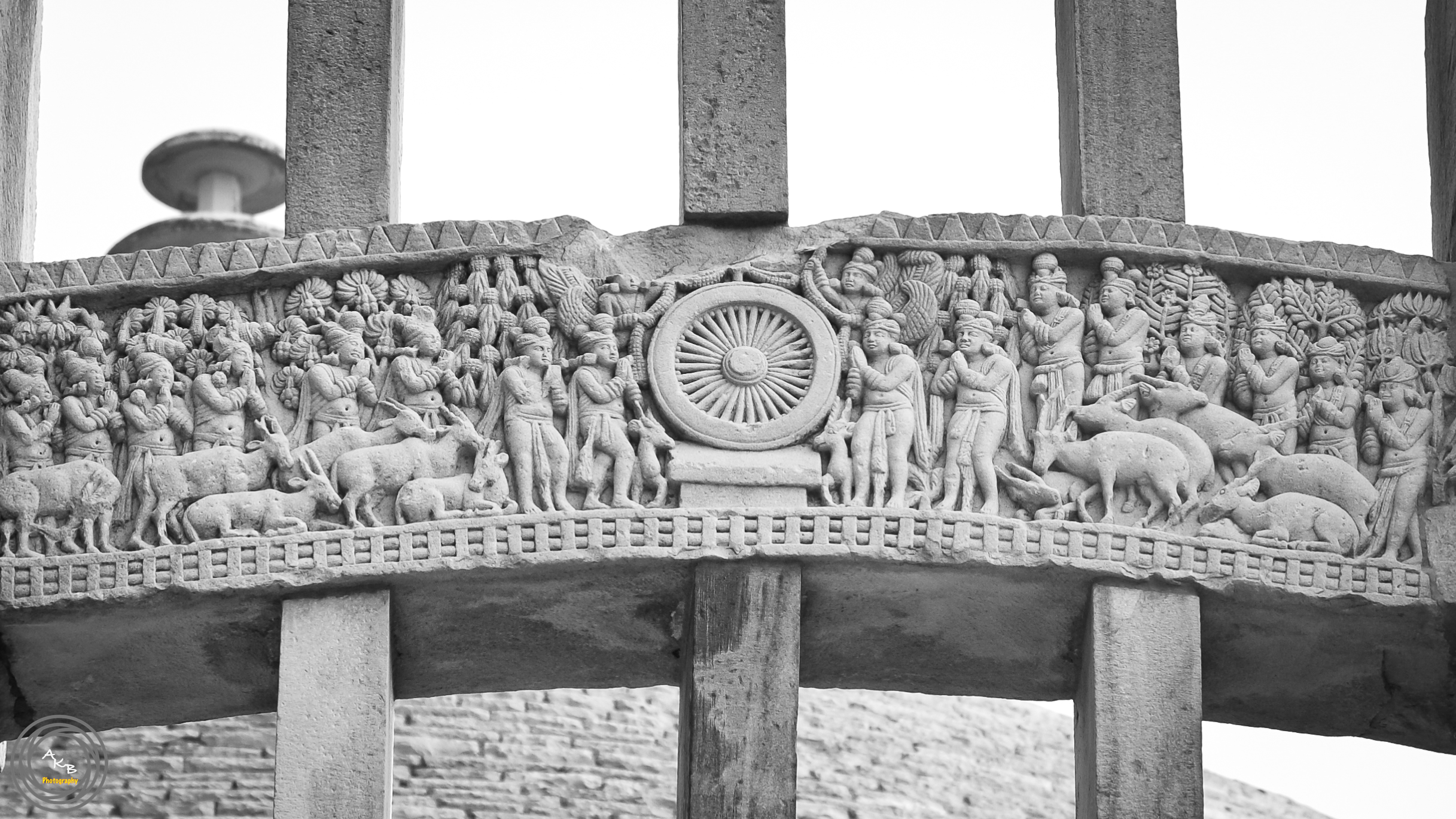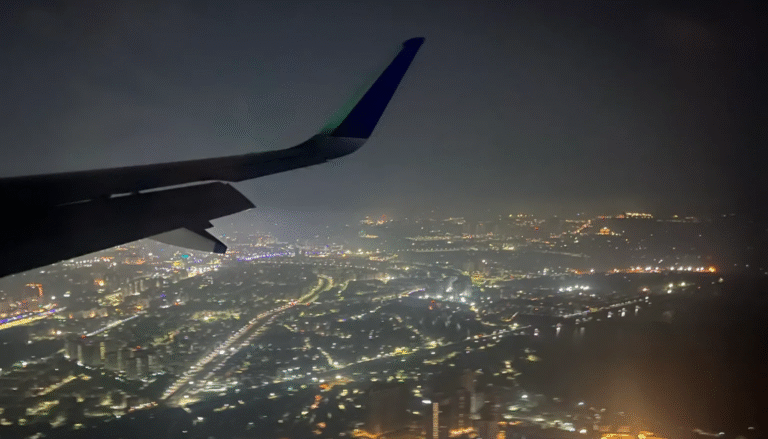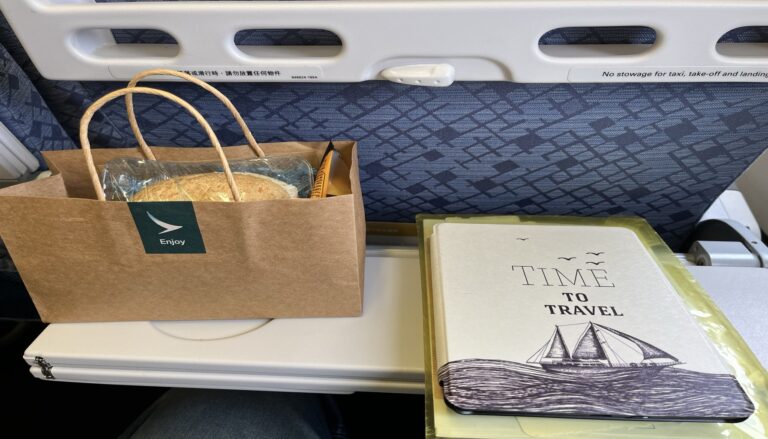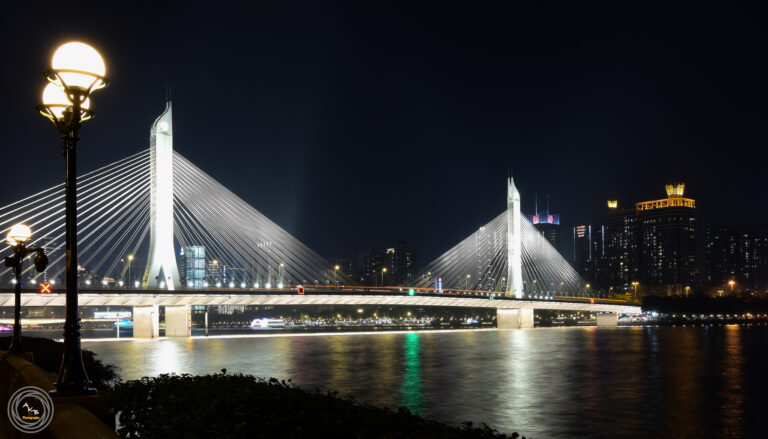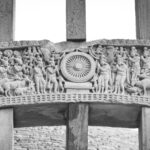Reaching there
It has been two months since I came to Bhopal, often called the ‘City of Lakes’ in Madhya Pradesh, the ‘Heart of India’. Sanchi is around 48 km by road from Bhopal city, and is considered an ‘outstation’ destination by private cab services like Ola and Uber. In that sense, Sanchi was my ‘outstation’ trip after coming to Bhopal.
Bhopal-Vidisha Highway connects Bhopal to the ancient city of Vidisha. Ashoka’s first wife, Devi, was from this town, and it has been said that Ashoka constructed Sanchi close to his wife’s hometown. We booked a round-trip Uber and started our journey at 9 am on a sunny Friday. On this highway, after driving for 30 km, we took a break. Not for replenishment, but to click photos at the Tropic of Cancer. The geographic imaginary line crosses the highway at a particular location and is clearly marked on both sides of the road.
After going for another 10 km, the Bhopal-Vidisha highway merges with NH146, which takes you straight to Sagar, a picturesque and beautiful city located in the north-central region of Madhya Pradesh. After going for another six km on NH146, we were at the gate of Sanchi. The time was 10:30 am.
Entering the complex
We stopped briefly at the ticket counter, which is situated outside the complex. I tried to purchase the tickets online by scanning the QR code just outside the booking counter window, but failed. Physical tickets finally served the purpose. There is a one-km stretch between the ticket counter and the stupa complex. Be prepared to walk this uphill stretch, as vehicles are not always allowed beyond the ticket counter. Our vehicle was also stopped halfway, citing the reason that the parking was full at the main entrance. So, we had to leave our vehicle there and walk the rest of the way. It took us 10 minutes. Our bags and tickets were scanned at the gate. No food items are allowed (we didn’t have any) inside the complex, but photography (we have many items) is allowed. We entered the ‘open-air museum’.
There are four stupas in the complex. As we entered the complex, the first thing we noticed was the Great Stupa (also called Stupa 1) at a distance of around a hundred meters. A bricked road has pierced through the green fields from the main gate to Stupa 1. It is the major attraction of Sanchi, and every picture you see, including the one on the back of the 200 rupee note, depicts it. We walked down the path and faced the Great Stupa first.
Sanchi is famous for its architectural and artistic beauty. But since its construction around 1300 years ago by Emperor Ashoka on a hilltop, Sanchi is famous as a spiritual and pilgrimage site. Its holy ground is thronged by devout Buddhists from all over the world.
Gateways – guide to enlightenment
Sanchi, and the first image that comes to mind is a gateway flanking the Great Stupa. Surrounding the Great Stupa, there are three more such gateways. Each of these four sandstone gateways, or toranas, is placed on the cardinal points. Each gateway consists of two square columns. The top of each column is crowned with lions, humans, or elephants that support a curved architecture with scrolled ends. Each gateway is elaborately crafted with ivory, wood, and metal, depicting scenes from the lives of Gautam Buddha, events from his life, and the history of Buddhism. These gateways were not present from the beginning — they were added later, during the first half of the first century CE, using the gifts and donations from various individuals or groups.
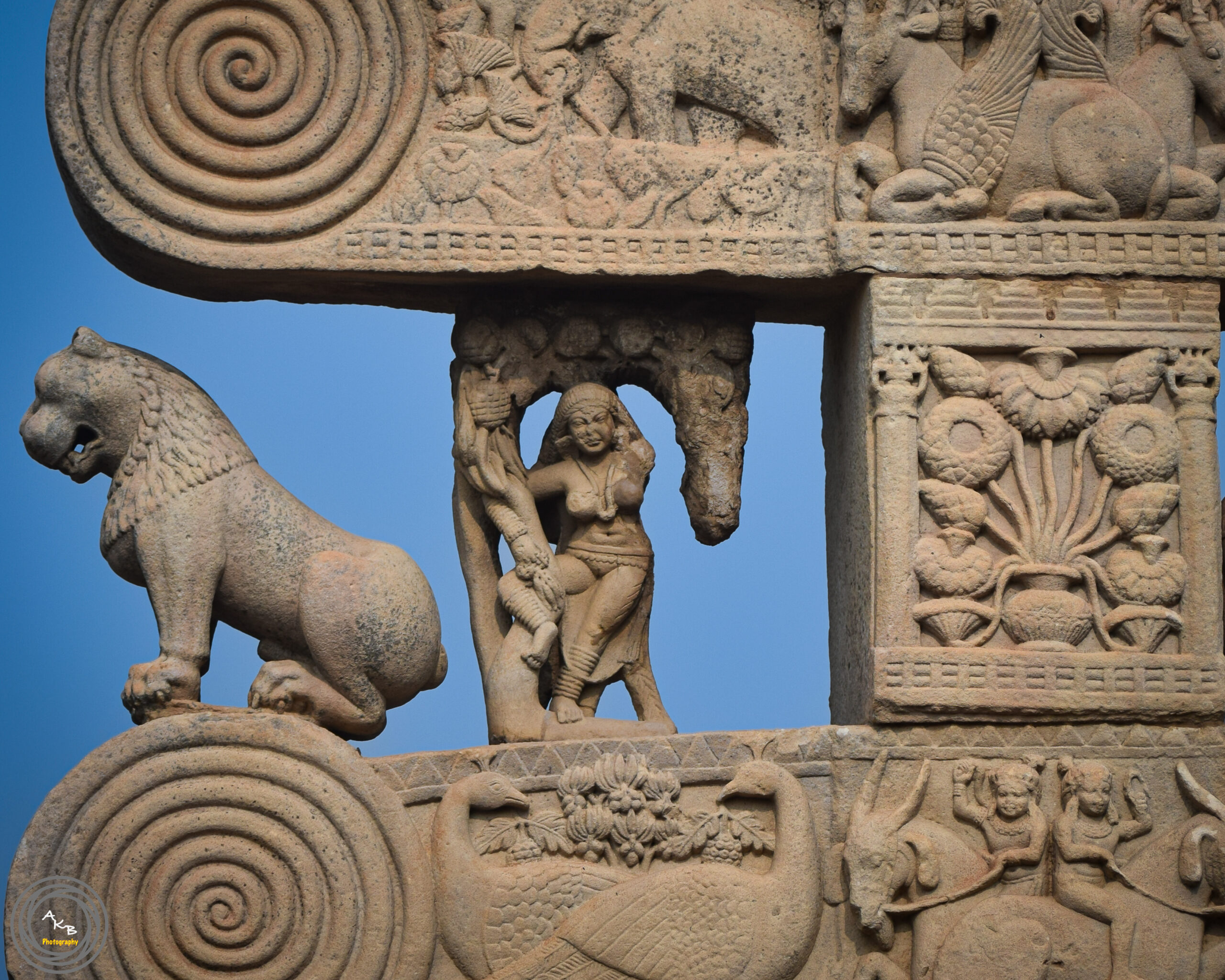
The intricately carved gateways of the Sanchi stupa influenced the decision to declare Sanchi as a UNESCO World Heritage Site in 1989.
The four gateways represent four great life events of the Buddha: East (birth), South (enlightenment), West (first sermon where he preached his teachings), and North (nirvana). The gateways also represent the ‘Four Noble Truths’, the teachings of Buddha:
- Life is suffering.
- The cause of suffering is desire.
- The cause of desire must be overcome.
- When desire is overcome, there is no more suffering.
The four gateways are, therefore, guiding the practitioner on the correct path to enlightenment, that is, understanding of ‘The Four Noble Truths’.
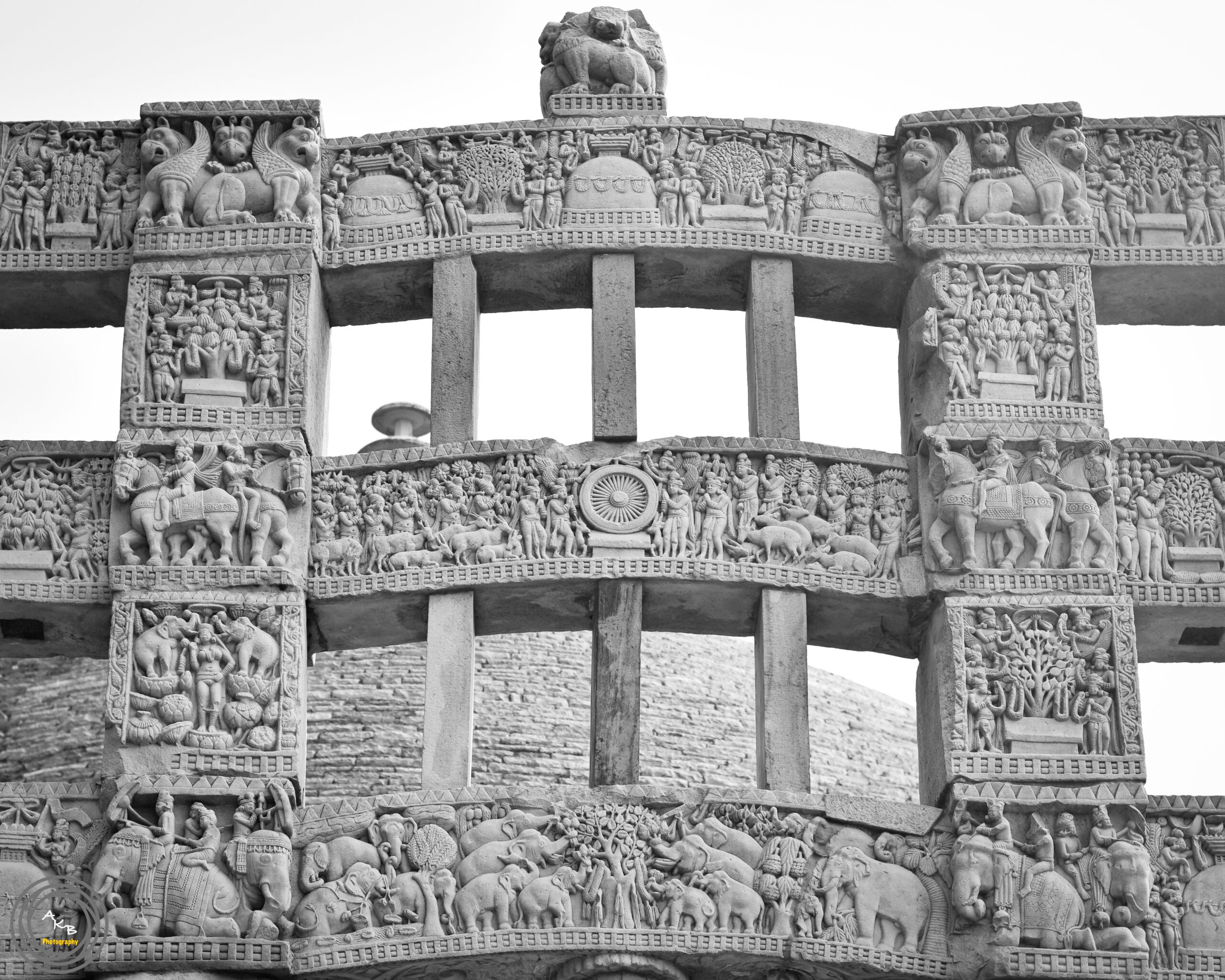
The first gate that we faced after walking down the brick road was the northern gate. And then we started moving anticlockwise – crossed the western gate, southern gate, and northern gate. Among these, the southern gate was believed to have been built first. The lion capitals, found on the top of the southern gate columns, resemble the lion capital at Sarnath.
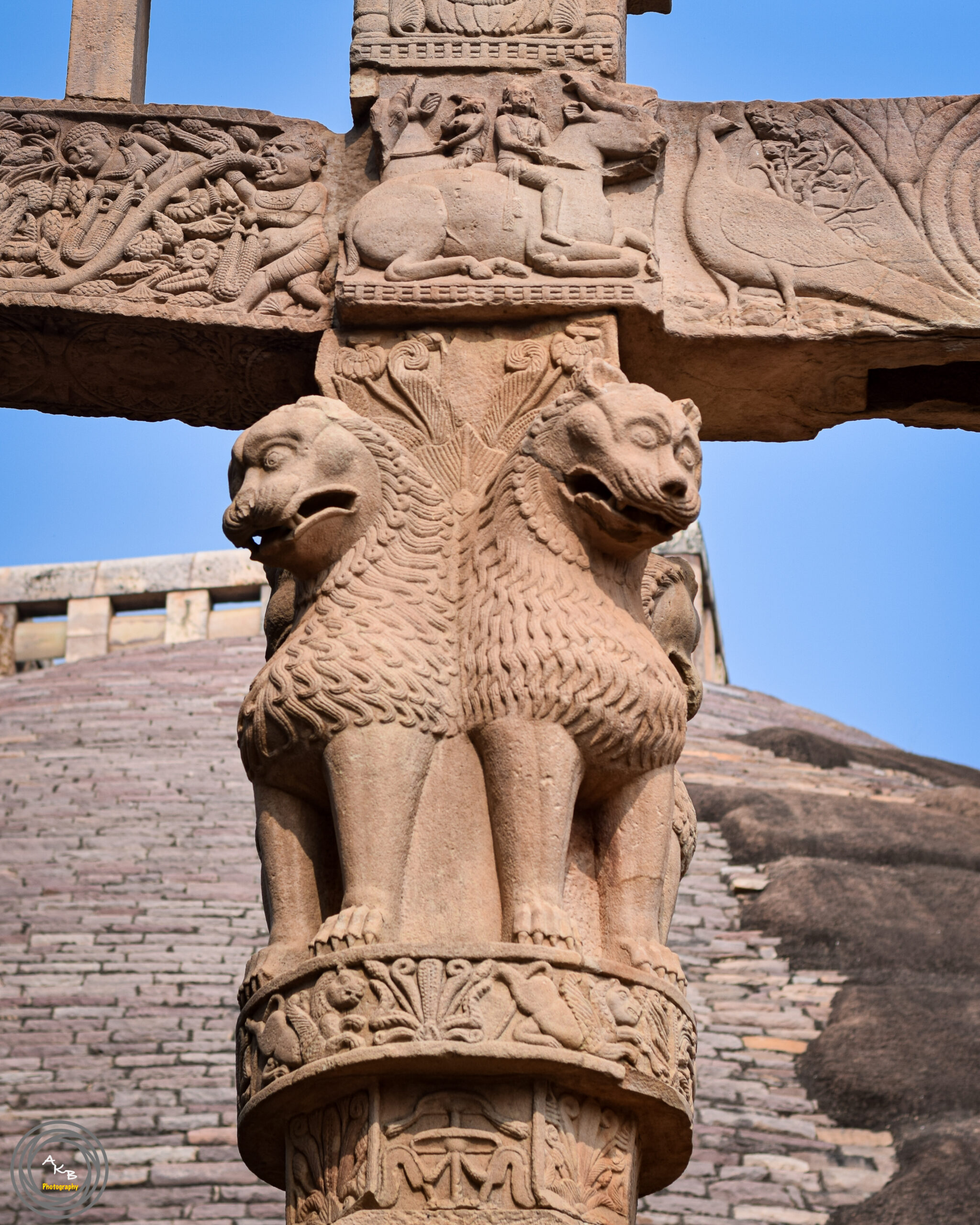
On the plaques in front of the gateways, you will find descriptions of the carvings drawn at different levels on the gateways. For example, you will find Emperor Ashoka worshipping the Great Stupa in level 2, and Gautam Buddha giving the first sermon of knowledge in level 4.
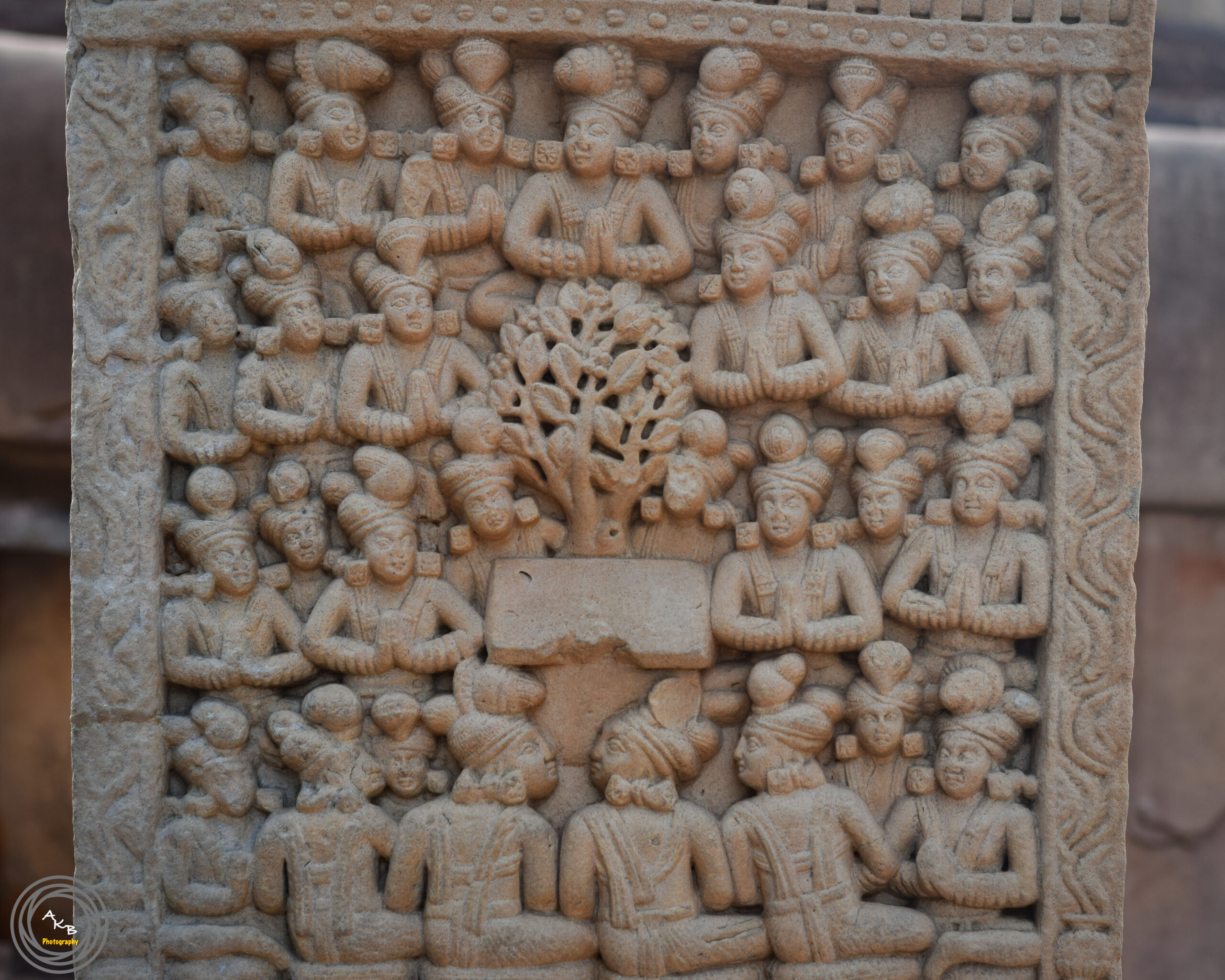
Opposite the southern gate, there lie the ruins of monasteries and a temple. The temple, also known as Temple 17, was constructed in the Gupta period. There is also one polished sandstone, known as the Ashoka Pillar, whose lion capital is in the Sanchi museum.
The Great Stupa
After visiting the four gates, it was time to enter the Great Stupa by any one of the four gateways. Much later, a souvenir shop-owner explained the Great Stupa to us.
You can imagine the dome-shaped Stupa as a person seated in meditation. The base of the stupa represents his crossed legs, the middle portion is the body, and the top of the dome, where a pole rises from the apex, represents his head. You enter through the gate and walk around (that is, circumambulating) the Stupa, just like Muslims circle the Kabba in Mecca, and move closer to the unmoving hub of the wheel, the Enlightenment.
We entered the ‘Great Stupa’ through the southern gate, completed the ‘pradakshina’ of the dome, and came out from the northern gate.
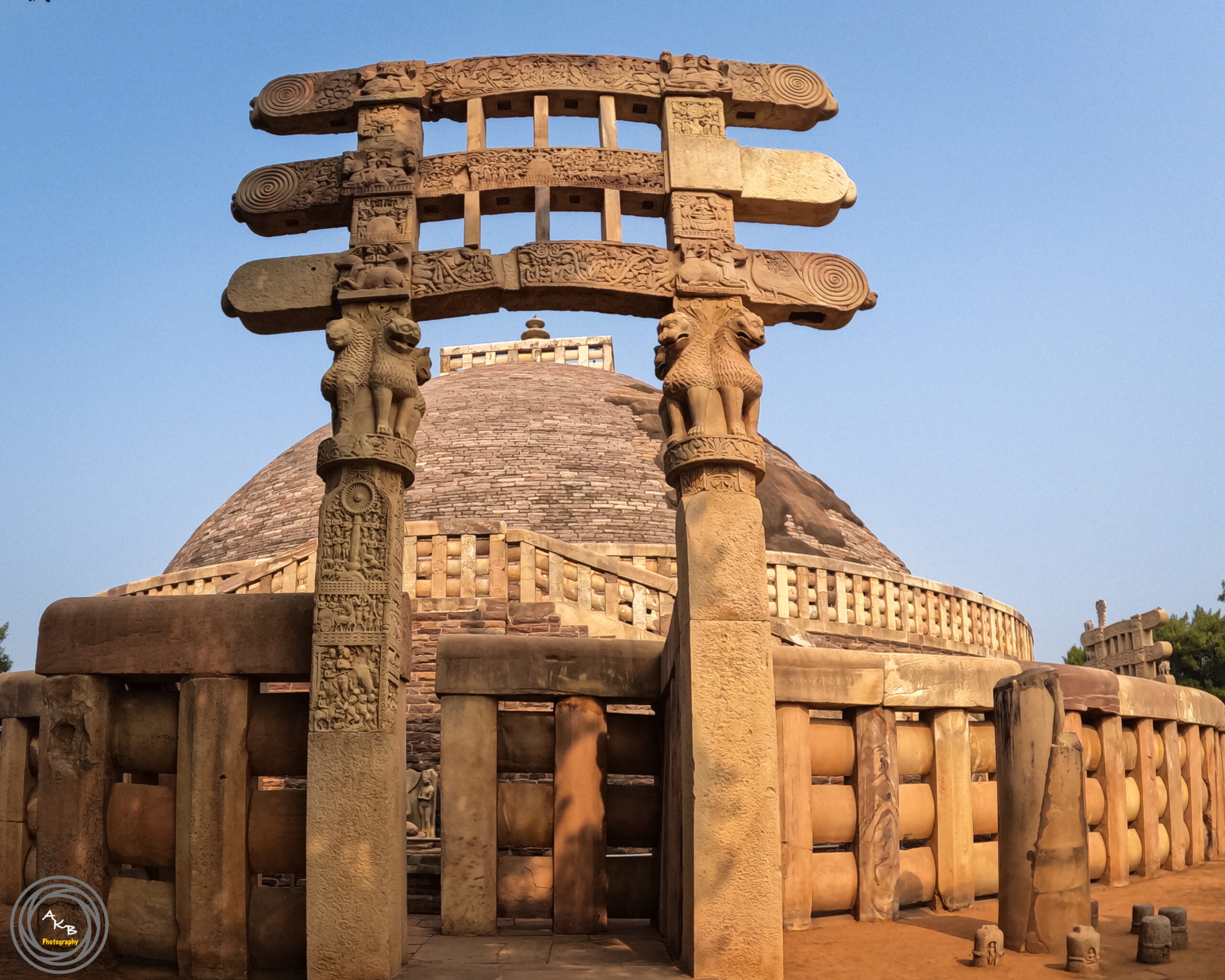
We walked right and found a flight of stairs leading down to another set of ruins of monasteries. We climbed down the stairs and saw a gigantic water tank and a feeding bowl once used by the monks. If we had moved along that path a little more and taken another set of stairs to go further down, we would have seen Stupa 2. But we came back from the ruins. We came back to the Great Stupa and started walking along the brick road to the main gate.
Buddhists have different names for different parts of the Stupa.
- The arched gateway is called ’torana’, the circumambulatory path is called ‘pradakshina patha’, the body of the Stupa is called ‘anda’, the pole at the top is called ‘yasti’, and the railed platform surrounding the ‘yasti’ is called ‘harmika’.
- The umbrella at the top of the ‘yasti’ is called ‘chattra’. People say that three umbrellas topping a stupa signify that the stupa contains the relics of Gautam Buddha, whereas one umbrella means the stupa has relics of a disciple of Gautam Buddha.
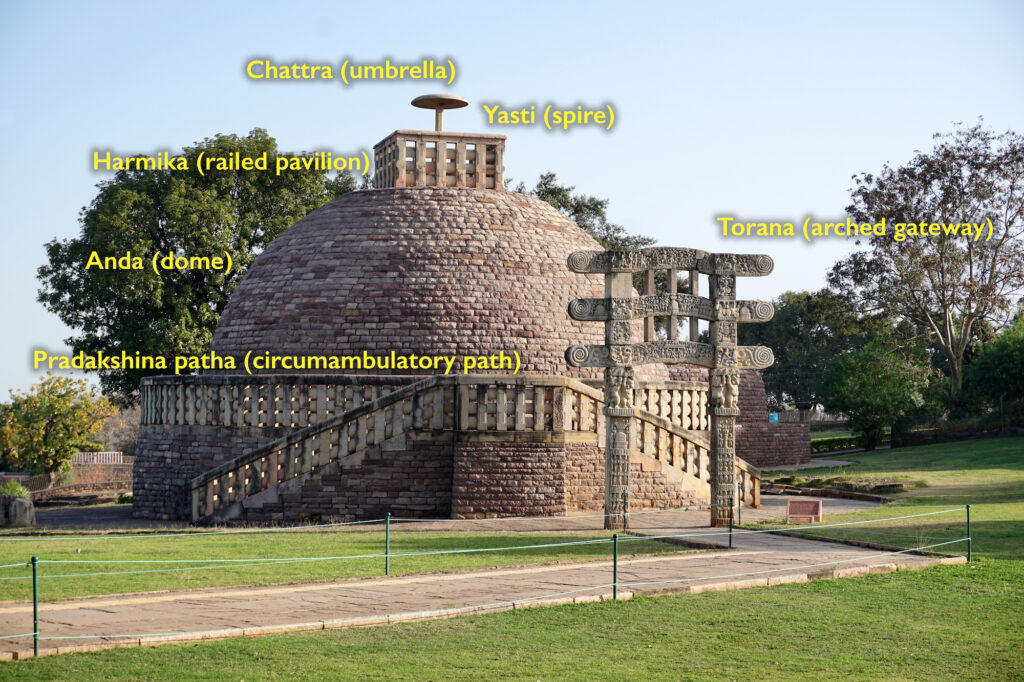
On our way, we took a right turn and visited the much smaller Stupa 3. Unlike Stupa 1, which has three circumambulatory paths around the dome, Stupa 3 only has one. It has one umbrella on top of the ‘yasti’, and a plaque of the Archaeological Survey of India in front of it, mentioning that about 100 years ago, bone relics of two disciples of Gautam Buddha, named Sariputra and Māghaḷāna, were discovered from the stupa (remember the connection between the number of umbrellas and the relics).
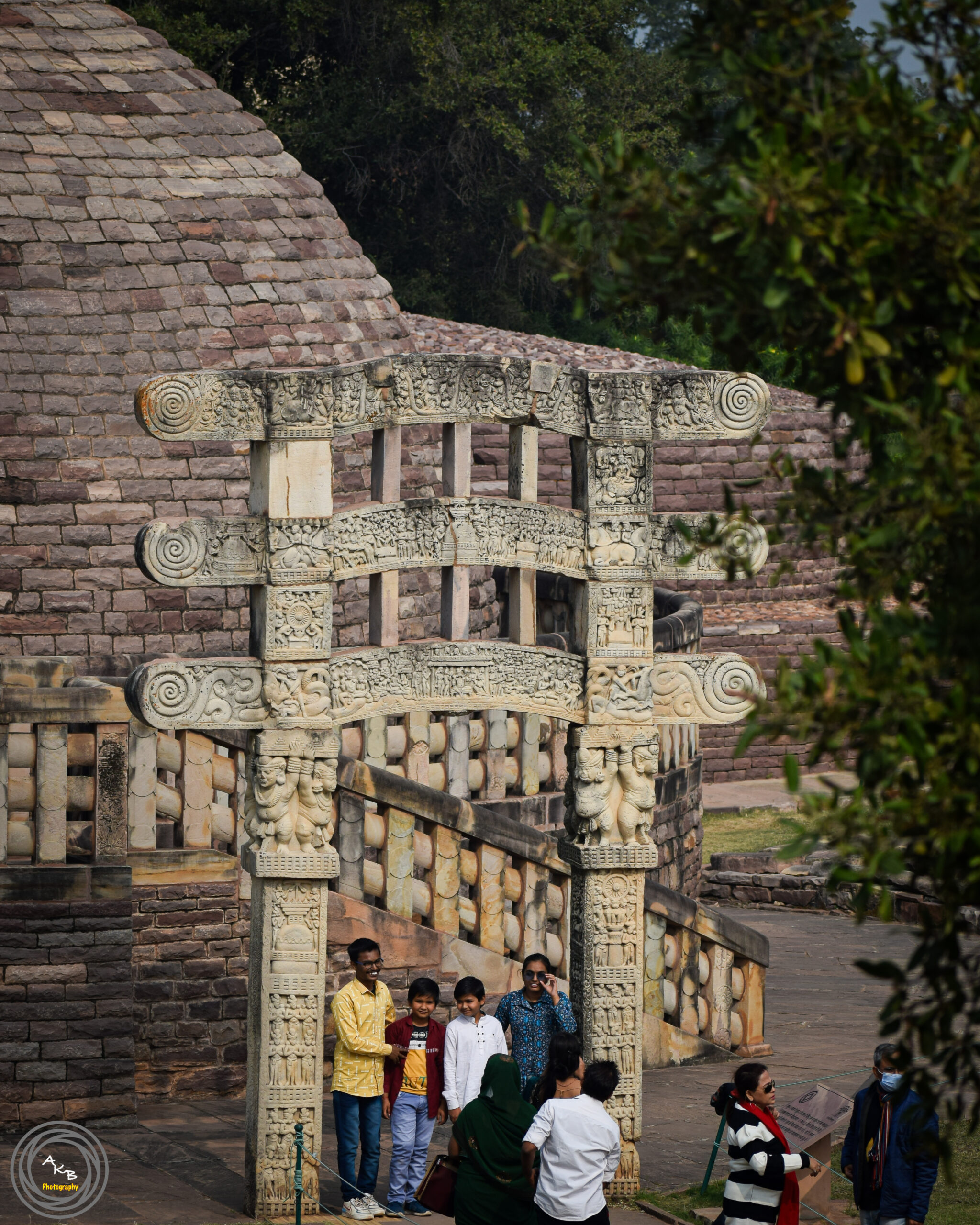
It has been said that the Great Stupa of Sanchi contains the relics of Gautam Buddha, as the three umbrellas on top of it depict that. While it is debatable, there is no doubt that Emperor Ashoka built many stupas throughout his Mauryan dynasty territory. The ashes of Gautam Buddha were buried in stupas built at locations associated with important events of Buddha’s life:
- Lumina (his birthplace)
- Bodh Gaya (where he achieved enlightenment)
- Sarnath (preached his first sermon), and
- Kushingara (where he died).
But prior to his death, Buddha expressed his wish that stupas should be erected in places other than those associated with key moments of his life so that many people can come and visit them. Therefore, Emperor Ashoka actually followed the directions of Buddha when he built these stupas all over northern India and in Nepal, Pakistan, Bangladesh, and Afghanistan.
I need to come back soon
On our way back, I was thinking when to come back here again. We did not see Stupa 2. We did not visit the museum, which is at the base of the hill, from where we bought our tickets. Amidst so many visitors and enthusiasts today, it is difficult to imagine that Sanchi was lost in the mist of time, behind the veil of dense forest. The gateways toppled over, on which greedy treasure hunters and amateur archaeologists roamed free. Who can imagine that the revered Ashoka pillar was used someday as a sugar-cane press by a local landowner? It was Sir John Marshall, the Director General of the Archaeological Survey of India, who restored Sanchi to its present condition after seven years of hard work. This time, we missed his house as well, which is located next to the Sanchi museum. I will come back here again.
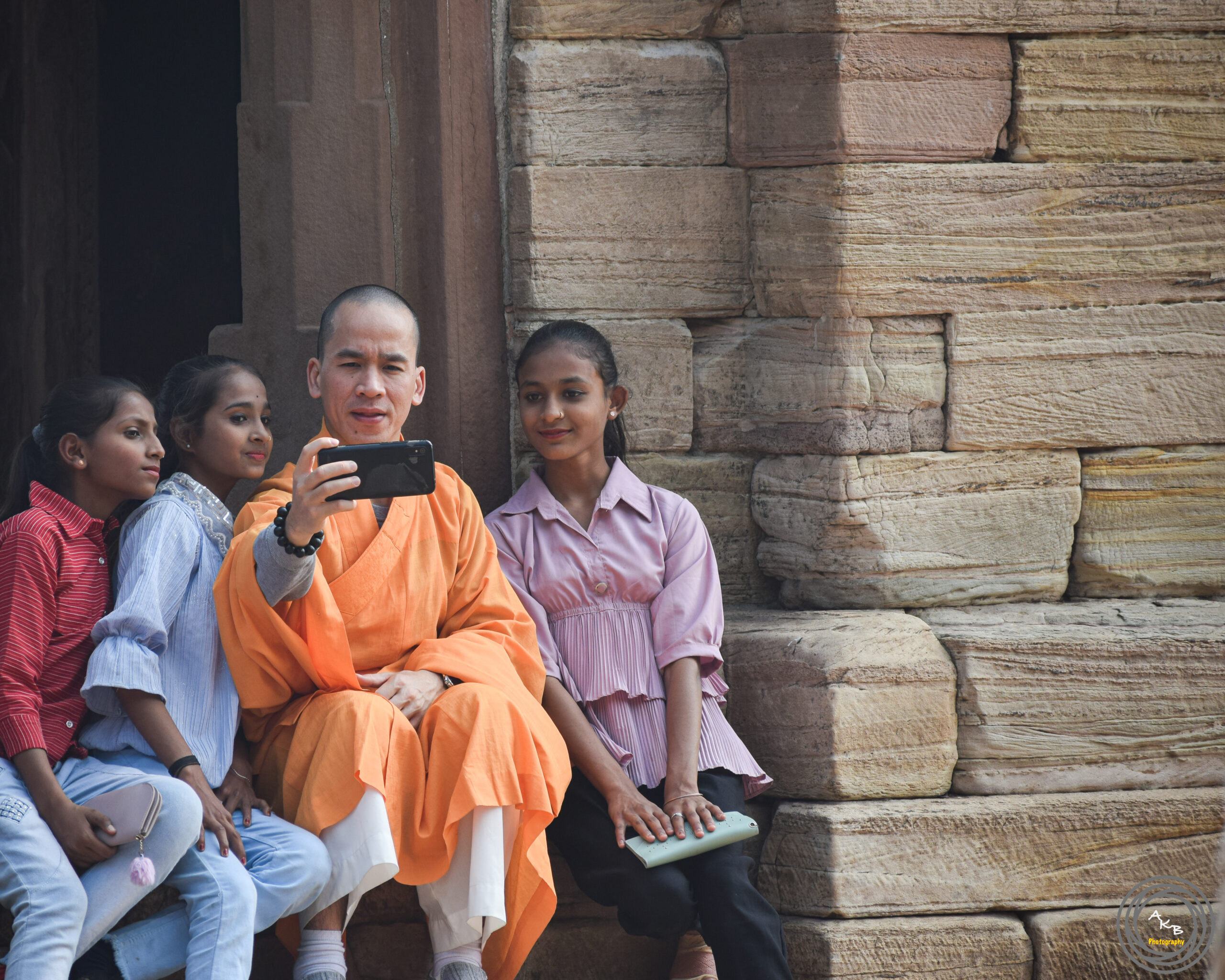
Travel tips
- Getting to Sanchi and back: We booked a round-trip Uber rental from Bhopal for 8 hours, and it cost us INR 1200. The car waited and brought us back.
- If you want to stay, Gateway Retreat, a Madhya Pradesh Tourism (MPT) property located within walking distance from the site. Auto rickshaws are available from the hotel to the site.
- Duration: It is better to stay in Bhopal and visit Sanchi on a day trip. Keep at least 4-5 hours in your hand to explore the site thoroughly.
- Best time to visit: October to March. Summer in Madhya Pradesh is hot.
- Entry fee and timing: INR 30 for Indians, INR 500 for foreigners. The site is open seven days a week, from sunrise to sunset (usually from 6:30 am to 6:30 pm).
- Museum visit: Entry fee is included in the site ticket. You can purchase it separately (INR 5). The museum is closed on Fridays.
- Photography is allowed within the site and the museum. No food or drink is allowed.
Read more
- https://ramaarya.blog/2018/03/23/sanchi-stupas-temples-monasteries/
- https://wanderingtalestraveldreams.com/2022/07/29/visiting-the-magnificent-stupas-in-sanchi-madhya-pradesh-india/
- https://mapacademy.io/article/gateways-at-sanchi-stupa-i/
- https://smarthistory.org/the-stupa-sanchi/
- https://www.mptourism.com/destination-sanchi.php

